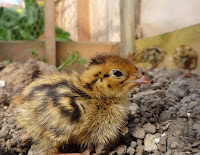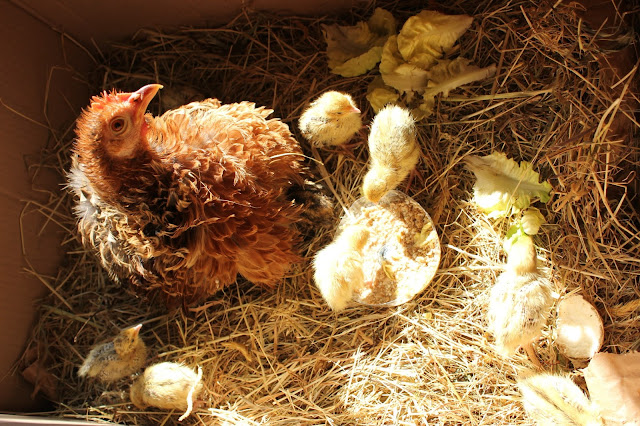For my 'field study', I am using the example of quail chicks, from non-organic purchased hatching eggs because this is the area in which, sadly I have a great deal of experience with deficiencies of all kinds but in particular, the B complex vitamins. I have however treated riboflavin deficiencies in hen chicks for neighbours and friends and the treatment and outcome are the same. However, in the delivery of the treatment with very small quail chicks, who are precocial, thus a great deal more independent than hen chicks, it is often useful to resort to subterfuge! Quail chicks are also obviously much smaller and thus any sort of treatment at this stage of development is a lot trickier, however as you will see, there are solutions.
Preparing to treat
The other thing to note with quail chicks (and with baby pigeons too), is that they are very susceptible to cold, particularly if they have been immobile, away from the parent and thus losing body heat. It is most important to get the chick ready for treatment by firstly getting its body temperature up, otherwise its system will have begun to 'close down' and the chick will have become less responsive and thus more difficult to treat. In a cold state you risk the problem of the chick not understanding what is expected of it, when presenting it with food and/or physically being unable to swallow and thus choking. So even if you are dealing with a hen chick, make sure the bird is 'up to temperature' and also that when and where you treat, the ambient temperature is sufficient. On a further note, do not over-heat the chick or this will make it sleepy and you will have similar problems! With a hen chick, who is with a mother hen and thus bonded to her, you should make sure that the chick is not stressed by being removed. If it is exhibiting symptoms of anxiety, then get a hay-lined cardboard box or similar receptacle and bring the hen and whole family in together to be there at the treatment. That way your chick will be aware of the Mother and she of it and you have a greater chance of effecting a complete cure. If this is too much to accomplish, then bring in at least one other sibling, to give some sense of comfort. At times of high anxiety, the body draws heavily on essential nutrients and as the B vitamins are some of the foremost requirements for the functioning of the nervous system, it is self-defeating to be administering vitamins which will immediately be lost to stress.
Above all, if possible, treat in the morning when the bird is hungry!
The Treatment - Nutritherapy
It is of tantamount importance to get B2 riboflavin into the bird's body as quickly and easily as possible and for this reason I am looking at foods that are both high in the vitamin and highly palatable to the bird.
A foreword about yeast flakes
Several people have asked me what I mean by yeast flakes as there is some confusion over a product called something along the lines of; 'fortified yeast flakes'. This is sold as a health supplement for vegans and is often, though not always, fortified with a synthetic cheap form of the B12 vitamin known as cyanocobalamin. Personally I would not under any circumstances be feeding this to a bird. You can tell from the prefix what this cobalamin contains but apart from that, any synthetic vitamin needs to be converted by the body to the natural form, to my mind this is not only pointless but also puts additional strain on a weakened chick. Furthermore, the bird's system can not convert synthetics in totality. Thus the bird will be left with chemical residues, which may be impossible to detox or cause an additional load to the bird's system to remove. It is also interesting to note that one of the richest sources for cyanocobalamin is activated sewage sludge. So when I mention yeast flakes as a treatment for riboflavin deficiency, I mean just that; flakes of yeast, which I buy from a bulk dispenser in my local organic shop. If you can't get pure organic yeast flakes, then with any other 'yeast flakes' I would check the packet for ingredients and additives.
As an alternative to yeast flakes the other highest form of B2, is in raw beef liver, organic beef liver is not pricey and the amount you need is very small. I always keep some in the freezer, ready to use in an emergency, although we eat it anyway. I would never advise using non-organic offal, the liver is effectively part of the body's waste disposal system, all pesticide and other toxic residues, not only pass through it but can be stored therein.
Other useful sources of B2 are;
- oily fish, such as mackerel
- hard boiled egg
- invertebrates (so having a compost heap is a great source)
- raw milk cheeses, such as Camembert
- Kale
- almonds
- sesame seeds
If one of your chicks exhibits riboflavin deficiency and you have had all your hatching eggs from the same source, it is a good idea to give them all some extra B complex rich foods, chances are they may all be deficient.
Administering yeast flakes
Although yeast flakes have quite a strong smell and thus taste, most birds seem to love them but there is always an exception. Another thing to take into consideration is, that when you are feeling weak or ill, it is often easier to drink rather than eat. Yeast flakes are water soluble, so mixing them with a liquid (including the highly nutritious organic raw virgin coconut oil) and getting the bird to sip it from a spoon may be easier (with one or two exceptions, as you will see in the film). My technique for getting a bird to drink is to introduce the tip of its beak to the liquid and to stroke the back of its head.
The Gourmet Fly
I have rarely found a quail chick who will not go crazy for a fly, so coating it in yeast flakes, like a breaded fish can sometimes be a useful ruse for a chick who turns its beak up at the raw flakes.
Covering all Contingencies
As with all deficiencies they tend to come in multiples and many leg and foot problems can also be traced to deficiencies in;
Selenium
This is something that is needed in very small amounts but without it the bird can become crippled and die. The very best way to get selenium into a bird is the Brazil nut and as selenium is toxic in large amounts and as the recommended allowance for Brazil nuts is around three per day for a human, the dosage for a quail chick is tiny. I usually just take one or two fine gratings from the end of the nut and add it to my yeast flakes.
You can also get selenium as a transdermal spray! I have found this an ideal delivery to treat the small chicks belonging to my neighbours and friends, the former have no bond with me, so it is quick and a lot less stressful for them.
Cobalamin - Vitamin B12 - the DNA Big Hitter
B12 deficiency is in epidemic proportions in the human population and amongst poultry and other livestock. The symptoms are so various that in any form of weakness in a bird, I would always be wanting to supplement this. It can only be found in animal protein, and only good quality to boot;
- Invertebrate wild protein from the compost heap is the tops but if this is not an option then
- raw beef liver,
- fish,
- shellfish,
- egg.
Folate - Vitamin B9
This vitamin works in synergy with B12, so it is necessary to feed both and here again, do not be confused with folic acid which is a synthetic vitamin and which actually depletes B12. The media, dictionaries, the internet and even health professionals use folate and folic acid as if they are the same, they are not! Folate can be found in a variety of leafy vegetables/vegetation;- broccoli
- turnip greens
- moss
- meadow pasture
- cauliflower
- bok choi
- lettuce
The Inuit, who traditionally have no access to fresh vegetables, do not have folate deficiency, which is a great illustration of the maxim that you are not only what you eat but what you eat eats. Caribou, which form a major part of the Inuit diet, live on sphagnum moss, which is a great source of folate, so by consuming the liver, where it is stored, the Inuit make up their requirement.
..and now if you'd like to, sit back and watch the film
Thanks for dropping by and do feel free to share experiences or ask for further information in the comment section. If you have enjoyed this piece and found it useful think about sharing it with your family and friends, on social media and also maybe about joining this blog and/or subscribing to my Youtube, Odysee or BitChute Channel or even supporting us on Patreon or
It all helps to keep me going!
Until next time, all the very best from sunny Normandie!
RELATED POSTS
 Identification of riboflavin deficiency in purchased quail and hatching eggs
Identification of riboflavin deficiency in purchased quail and hatching eggs
Quail have a high basal metabolic rate and as such their problems with nutrition are dramatically and rapidly revealed...read more
Common Nutritional Deficiencies in Quail, Game-birds & Poultry
Many nutritional deficiencies in chicks are in fact due to gaps in parental diet, which impact directly upon the quality of the embryo's nutrition and therefore start within the shell..read more
 Emergency Treatment, Follow-ups and Keeping Calm
Emergency Treatment, Follow-ups and Keeping Calm
The
great thing about this emergency treatment is that it is concocted from
simple foodstuffs you probably have to hand in your kitchen
cupboards...read moreRETURN TO CONTENTS PAGE
© 2016 Sue Cross

















